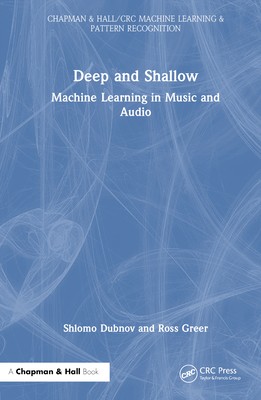
- We will send in 10–14 business days.
- Author: Shlomo Dubnov
- Publisher: CRC Press
- ISBN-10: 1032146184
- ISBN-13: 9781032146188
- Format: 15.6 x 23.4 x 2.1 cm, hardcover
- Language: English
- SAVE -10% with code: EXTRA
Reviews
Description
Providing an essential and unique bridge between the theories of signal processing, machine learning and artificial intelligence (AI) in music, this book provides a holistic overview of foundational ideas in music, from the physical and mathematical properties of sound to symbolic representations. Combining signals and language models in one place, this book explores how sound may be represented and manipulated by computer systems, and how our devices may come to recognize particular sonic patterns as musically meaningful or creative through the lens of information theory.
Introducing popular fundamental ideas in AI at a comfortable pace, more complex discussions around implementations and implications in musical creativity are gradually incorporated as the book progresses. Each chapter is accompanied by guided programming activities designed to familiarise readers with practical implications of discussed theory, without the frustrations of free-form coding.
Surveying state of the art methods in applications of deep neural networks to audio and sound computing, as well as offering a research perspective that suggests future challenges in music and AI research, this book appeals to both students of AI and music, as well as industry professionals in the fields of machine learning, music and AI.
EXTRA 10 % discount with code: EXTRA
The promotion ends in 18d.14:11:44
The discount code is valid when purchasing from 10 €. Discounts do not stack.
- Author: Shlomo Dubnov
- Publisher: CRC Press
- ISBN-10: 1032146184
- ISBN-13: 9781032146188
- Format: 15.6 x 23.4 x 2.1 cm, hardcover
- Language: English English
Providing an essential and unique bridge between the theories of signal processing, machine learning and artificial intelligence (AI) in music, this book provides a holistic overview of foundational ideas in music, from the physical and mathematical properties of sound to symbolic representations. Combining signals and language models in one place, this book explores how sound may be represented and manipulated by computer systems, and how our devices may come to recognize particular sonic patterns as musically meaningful or creative through the lens of information theory.
Introducing popular fundamental ideas in AI at a comfortable pace, more complex discussions around implementations and implications in musical creativity are gradually incorporated as the book progresses. Each chapter is accompanied by guided programming activities designed to familiarise readers with practical implications of discussed theory, without the frustrations of free-form coding.
Surveying state of the art methods in applications of deep neural networks to audio and sound computing, as well as offering a research perspective that suggests future challenges in music and AI research, this book appeals to both students of AI and music, as well as industry professionals in the fields of machine learning, music and AI.


Reviews